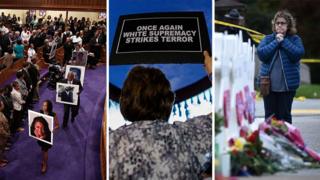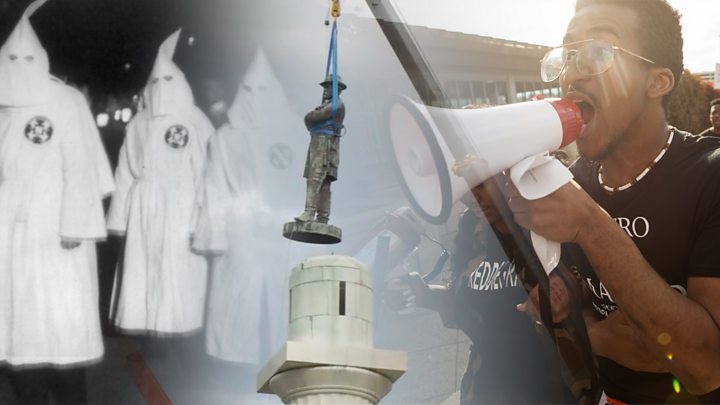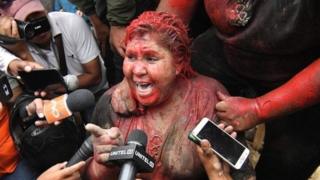 Image copyright
Image copyright
Getty Images
US authorities are investigating the shootings in El Paso that left 22 people dead as a possible case of “domestic terrorism”. How big a threat is this kind of terror and how is the US combating it?
Police believe the white suspect, Patrick Crusius, drove hundreds of miles across Texas to a Hispanic-majority city to carry out his attack.
He is believed to be the author of a document posted minutes before the shooting which said the attack was “a response to the Hispanic invasion of Texas”.
In a statement, the FBI said the attack “underscores the continued threat posed by domestic violent extremists and perpetrators of hate crimes”.
It also said it was concerned that “US-based domestic violent extremists could become inspired by these and previous high-profile attacks to engage in similar acts of violence”.
Last month, the FBI said this kind of violence was on the rise and most of it was motivated by some form of white supremacist ideology.
So how big a problem is it?
Right-wing extremists were linked to at least 50 killings in 2018, making it one of the worst years in terms of right-wing violence since 1995, according to researchers with the Anti-Defamation League (ADL), an organisation that monitors hate crimes.
Approximately three-fourths of killings by extremists have been carried out by those affiliated with white supremacist groups, according to the ADL researchers.
The violence inflicted by individuals linked to right-wing groups, whether through their online connections or ideological affinity, was making grim national and international headlines long before El Paso.
One woman was killed at a synagogue in Poway, California, in April, while 11 people died in an attack on a synagogue in Pittsburgh last year.
Analysts say these killers share a common ideology, one of violence, bigotry and hate, and are fuelled by people they meet in online communities such as 4chan and 8chan, places where they have been able to discuss freely white nationalism and other virulent forms of racism.
- ‘I’ve never been scared of being Hispanic – until now’
- Does Trump’s plan to end gun violence make sense?
Are the US authorities doing enough?
FBI officials say their investigations have kept apace with the rising threat from these groups.
In July, FBI Director Christopher Wray told members of the US senate judiciary committee that agents had made dozens of arrests in domestic terrorism cases over the previous nine months.
Wray said these cases included two different categories – “homegrown violent extremism”, a term that he and other FBI agents use to describe individuals who are inspired by “global jihadists”, and “domestic extremism”, a group that, according to Wray, includes those who are “motivated by some version of what you might call white supremacist violence”.
FBI agents arrested about 100 individuals in each category, encompassing those who have an affinity for “global jihadists” as well as those who are driven by “white supremacist” ideology, he said.
But others disagree with Wray’s assessment of the bureau’s work. They say that regardless of the number of arrests that have been made over the past several months, FBI agents and other federal authorities have paid less attention than they should to fighting right-wing extremism in the US.
These critics say that the federal authorities have placed too much emphasis on ferreting out supposed “jihadists” in the US and have “let the ball drop” in their effort to combat white-supremacist groups.
“White supremacist terror has not gotten the attention that Islamist terror has,” says Dartmouth College’s Daniel Benjamin, who worked as the US State Department’s coordinator for counterterrorism from 2009 to 2012.
“The FBI and later DHS [the US department of homeland security] turned their attention to the jihadist threat and left the white-supremacist threat behind.”
The 9/11 factor
After al-Qaeda’s attack on the US in 2001, Washington officials put enormous resources into counterterrorism efforts. According to a report by the Washington-based Stimson Center, the US spent $2.8tn during fiscal years 2002 until 2017 on counterterrorism, a global campaign to tamp down extremist violence that was waged through the military and other means.
Of this amount, spending on homeland security – or keeping people within the US safe – accounted for 35% or approximately $979bn.
Over time, according to analysts, the investment of resources into combating threats from groups such as al-Qaeda and so-called Islamic State meant that other threats received less attention. Yet the danger from the white extremist groups continued to grow.
“We have – understandably – been as tight as a bow on Islamic extremism,” says Mr Benjamin. As soon as authorities find out that someone has ties to international jihadist groups, he says, the authorities place these individuals under surveillance.

Media playback is unsupported on your device
But the attacks on synagogues in the US, assaults perpetrated by individuals affiliated with right-wing extremist groups, have not resonated with authorities in the way that threats from jihadist groups did in the past. “The mass shooting phenomenon is seen as part of the American way of life – unfortunately,” he says. “And not as much attention has been paid to the ideology behind these attacks.”
He says there is another element that contributes to the authorities’ relatively low-key treatment of white-supremacist groups: an underlying current of racism in this country. “The officials haven’t been as exercised by a threat from within – and by people who look like them – as they were by a threat from without and with an alien ideology. After all, white supremacist ideology has been an element of the American way of life since long before the civil war.”
“It’s dreadful,” he says. “Appalling.”
Mike German, a former undercover FBI agent who is now with New York University’s Brennan Center, agrees. He says the FBI has not “treated all terrorists the same”, explaining that agents have “focused on Muslims and Muslim-Americans but meanwhile the lethal threat posed by white supremacists has gotten ignored”.
“There’s no question that white supremacists and far-right groups kill more than other groups,” he says. “But we just have this huge blind spot about the far right and racist violence.”
A changing landscape of threats
Some of the most powerful right-wing extremist organisations in the US existed well before 9/11. One of the groups, Stormfront, which analysts describe as a white supremacist website, was created in 1996, and it acted as an inspiration for Dylann Roof, the gunman who killed nine people in a church in Charleston in 2015. Another site, the Daily Stormer, has been around for years.
But recently the online communities for right-wing extremists and white nationalists have grown in popularity and strength, and the radicalisation time for new converts has speeded up dramatically.
“The interval from flash to bang” – from the moment when someone is first exposed to an ideology to an actual attack – “has radically decreased”, says John Farmer, a former US attorney general and the author of The Ground Truth: The Untold Story of America Under Attack on 9/11.
The radicalisation process used to take months or years. Now, he says: “It’s just a couple weeks.” This makes it harder for federal authorities to ferret out the violent plots and to find the individuals who are planning an assault.
Image copyright
Getty Images
A vigil outside the White House after a white supremacist killed a woman in Charlottesville, Virginia
What will happen now?
Many people question whether US officials are well placed in their efforts to face the new threats from right-wing extremists.
Some argue that the authorities are up to the challenge. “The FBI has done a great job,” says Richard Barrett, former director of global counterterrorism operations at MI6, Britain’s foreign intelligence agency. “They’ve been keeping a close eye on these groups – and have been on it for some time.”
Federal authorities are investigating the shootings in El Paso as a possible case of domestic terrorism. They are also trying to stop right-wing extremists from seizing social-media and online platforms and have forced one service to be shut down.
In addition FBI officials have begun to describe those who believe in radical conspiracy theories as a potential threat, a first for the bureau, as a Yahoo News reporter writes, and a sign that the agents are grappling with a new constellation of threats, one that includes right-wing extremism as well as ideologies that are imported from abroad.
But many see it as an uphill fight. The president has previously been accused of playing down the threat from far-right groups. He’s also been criticised for stoking intolerance towards minorities at his political rallies. A few months ago, he spoke at a rally in a part of Florida that is known as the “panhandle” about an “invasion” of immigrants.
“Shoot them,” someone called out. In response Trump made a joke: “That’s only in the panhandle you can get away with that stuff.”
On Monday Trump took a much stronger line after the attacks in El Paso: “In one voice our nation must condemn racism, bigotry and white supremacy,” he said, though it took the normally hyper-reactive president 24 hours to speak these words.
The president’s critics are waiting to see whether he now sticks with this tougher stance or whether his language softens when the immediate political crisis blows over and he gets back on the campaign trail.












